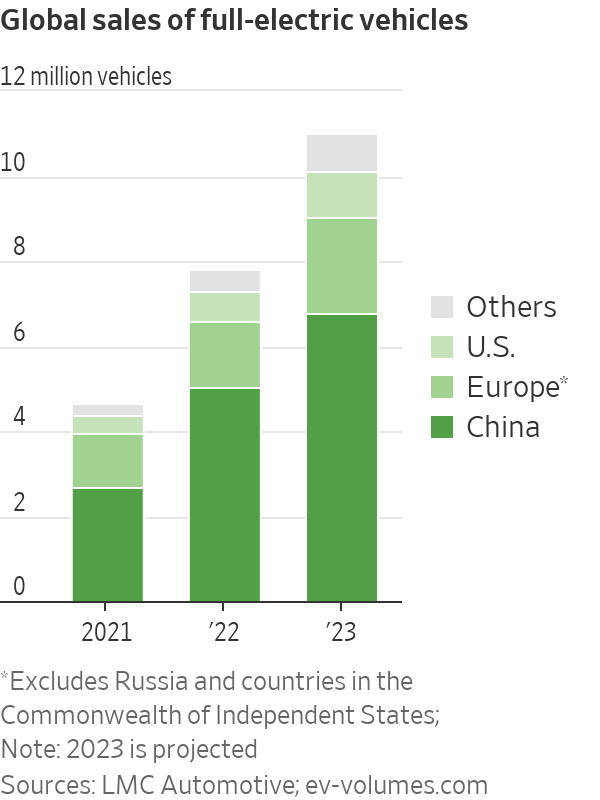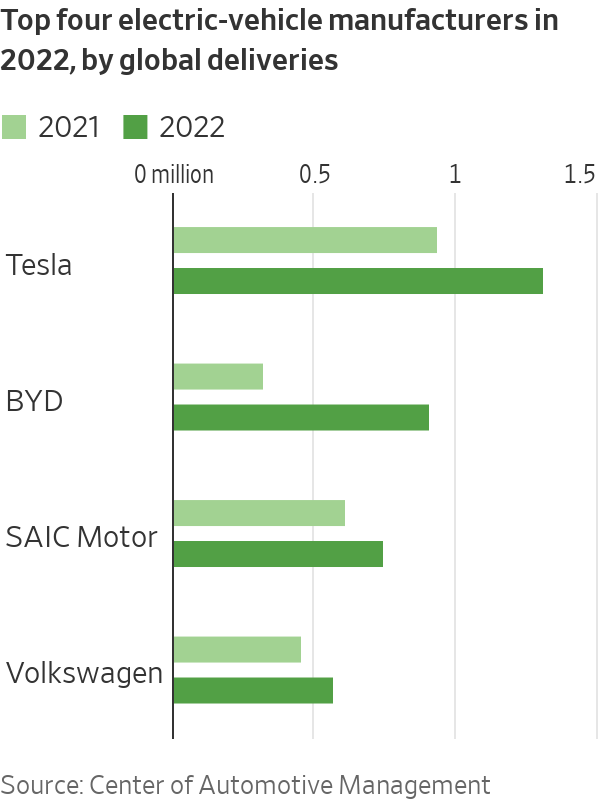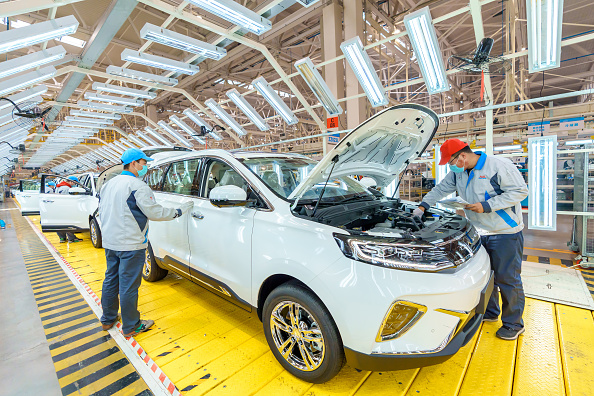EVs Made Up 10% of All New Cars Sold Last Year
China, Europe drive electric-vehicle expansion as U.S. gains traction
BERLIN—Electric-vehicle sales crossed a key milestone last year, achieving around 10% market share for the first time, driven mainly by strong growth in China and Europe, according to fresh data and estimates.
While EVs still make up a fraction of car sales in the U.S., their share of the total market is becoming substantial in Europe and China, and they are increasingly influencing the fortunes of the car market there as the technology goes mainstream. The surge in EV sales also contrasted with the broader car market that suffered from economic worries, inflation and production disruptions.

Global sales of fully electric vehicles totalled around 7.8 million units, an increase of as much as 68% from the previous year, according to preliminary research from LMC Automotive and EV-Volumes.com, research groups that track automotive sales.
Ralf Brandstätter, the head of Volkswagen AG’s China business, told reporters on Friday that electric vehicles would continue expanding fast and that China could soon reach a point where sales of conventional vehicles begin to permanently decline as plug-in vehicles take bigger market share.
“Last year, every fourth vehicle we sold in China was a plug-in, and this year it will be every third auto,” Mr. Brandstätter said. “We haven’t reached the tipping point yet, but we’re expecting to get there between 2025 and 2030.”
For the full year, fully electric vehicles accounted for 11% of total car sales in Europe and 19% in China, according to LMC Automotive. Combined with plug-in hybrid vehicles, which can be plugged in to recharge the battery but also have a small combustion engine, the share of electric vehicles sold in Europe rose to 20.3% of the total last year, according to EV-Volumes.com.
The U.S. lags behind China and Europe in the rollout of EVs, but last year auto makers sold 807,180 fully electric vehicles in the U.S., a rise in the share of all-electric vehicles to 5.8% of all vehicles sold from 3.2% the year before. Tesla is still the world’s dominant EV maker, but conventional auto makers are shortening its lead with new electric-model launches.
In Germany, the largest auto market in Europe, electric vehicles accounted for 25% of new vehicle production last year, according to VDA, the German automotive manufacturers association. In December, there were more EVs sold in the country than conventional cars.
New-car sales overall fell around 1% to 80.6 million vehicles, according to the LMC data, with nearly 4% growth in China helping to offset a decline of 8% in the U.S. and 7% in Europe, which was hit by the weakening global economy, soaring energy costs, supply-chain disruptions and the war in Ukraine.
Bayerische Motoren Werke AG, the German luxury-car maker, was one of many manufacturers last year to see sales of plug-in models rise even as overall sales tumbled. BMW reported a 5% decline in total new-car sales but saw EV sales more than double last year.
“We are confident that we can repeat this success next year, because we have a continued high order backlog for fully electric models,” BMW sales chief Pieter Nota, said this month, commenting on the growth in sales of electric models.
VW, Europe’s biggest manufacturer by sales, said on Thursday that overall new-car sales fell 7% to 8.3 million vehicles last year, but sales of electric vehicles rose 26% to 572,100 units. The sales figures encompass the company’s large stable of brands, including VW, sports-car maker Porsche, luxury-car brand Audi and passenger-car brands Skoda and Seat.
The bulk of VW’s sales of EVs were in Europe, but sales growth was strongest in China and the U.S., the company said.
Other manufacturers reported a similar divide of strong growth in sales of electric cars—boosted in part by the availability of a wider array of models in addition to market leader Tesla Inc.—and weak or declining sales of conventional vehicles. Ford Motor Co., Mercedes-Benz Group AG and BMW each said their EV sales more than doubled in 2022, while their total vehicle sales declined.
Photos: The EV Rivals Aiming for Tesla’s Crown in China
European auto makers have focused their EV production and sales on home markets as they try to meet European Union emissions regulations. They also began last year to more aggressively expand their EV business in other major markets, especially China and the U.S.
In China, which accounted for around two-thirds of global sales of fully electric cars last year, domestic manufacturers are gaining ground on traditional Western auto makers and are also beginning to expand into Europe and the U.S.
Worldwide, Tesla maintained the top spot in a global ranking of manufacturers by sales of all-electric vehicles, followed by Chinese manufacturers BYD Co. and SAIC Motor Corp., and brands belonging to the VW group, according to a study published by Stefan Bratzel, director of the Center of Automotive Management, an automotive-research group in Germany.

In the U.S., Ford is the second-largest maker of EVs by sales, followed by Hyundai Motor Co. and its affiliate Kia Corp. Meanwhile, General Motors Co., VW and Nissan Motor Co. lost EV market share in the U.S. last year.
While EVs are showing signs of becoming more mainstream globally, analysts warn that repeating last year’s strong EV performance in 2023 could be difficult as economic worries weigh on consumers, and cash rebates on EVs are reduced or scrapped completely in some countries. Rising electricity prices in Europe in the wake of Russia’s attack on Ukraine have also diminished the appeal of EVs compared with gas-powered cars.
Germany witnessed a surge in last-minute EV purchases in December, as consumers rushed to take advantage of government incentives before they were cut this year. Since Jan. 1, government subsidies for the purchase of an EV with a listing price of up to 40,000 euros, equivalent to about $43,000, fell to 4,500 euros from 6,000 euros previously.
For the past couple of years, auto makers, especially in Europe, have struggled to find key components such as computer chips to maintain production in pace with demand. This mismatch between demand and supply is one reason auto makers posted lofty profits last year despite broadly weaker sales.
As the economy weakens, supply-chain problems ease and subsidies dry up, manufacturers could find it harder to maintain the high prices for new cars as they chase potentially fewer buying customers. This could result in a downward price spiral that potentially hits profits.
“Demand is likely to weaken in the coming year,” said Peter Fuss, an auto analyst with Ernst & Young. “The weak economy will cause retail and business consumers to be more reluctant. And it is possible that supply will outpace demand and we will begin to see discounts again.”
 Copyright 2020, Dow Jones & Company, Inc. All Rights Reserved Worldwide. LEARN MORE
Copyright 2020, Dow Jones & Company, Inc. All Rights Reserved Worldwide. LEARN MORE
Pure Amazon has begun journeys deep into Peru’s Pacaya-Samiria National Reserve, combining contemporary design, Indigenous craftsmanship and intimate wildlife encounters in one of the richest ecosystems on Earth.
Australia’s housing market defies forecasts as prices surge past pandemic-era benchmarks.
Pure Amazon has begun journeys deep into Peru’s Pacaya-Samiria National Reserve, combining contemporary design, Indigenous craftsmanship and intimate wildlife encounters in one of the richest ecosystems on Earth.
Pure Amazon, an A&K Sanctuary, has officially launched its voyages into the 21,000-square-kilometre Pacaya-Samiria National Reserve.
Designed for just 22 guests, the new vessel positions itself at the high end of wilderness travel, offering quiet, immersive, and attentive experiences with a one-to-one staff-to-guest ratio. The focus is on proximity to wildlife and landscape, without the crowds that have made parts of the Amazon feel like tourism has arrived before the welcome mat.
Where Architecture Meets the River
The design direction comes from Milan-based architect Adriana Granato, who has reimagined the boat’s interiors as part gallery, part observatory. Floor-to-ceiling windows frame rainforest scenes that shift hour to hour, and every space holds commissioned artworks by Peruvian artists.
The dining room’s centrepiece, Manto de Escamas de Paiche by Silvana Pestana, uses bronze and clay formations that mirror the scale patterns of the Amazon’s giant fish. Pestana’s works throughout the vessel reference environmental fragility, especially the scars left by illegal gold mining.
In each suite, hand-painted kené textiles by Shipibo-Konibo master artist Deysi Ramírez depict sacred geometry in natural dyes. Cushions by the BENEAI Collective feature 20 unique embroidered compositions, supporting Indigenous women artists and keeping traditional techniques alive in a meaningful, non-performative way.
Wildlife Without the Tame Script
Days on board are structured around early and late river expeditions led by naturalist guides. Guests may encounter pink river dolphins cutting through morning mist, three-toed sloths moving like they’re part of the slow cinema movement, and black caimans appearing at night like something from your childhood nightmares.
The prehistoric hoatzin appears along riverbanks, giant river otters hunt in packs, and scarlet macaws behave like the sky belongs to them. The arapaima — the same fish inspiring Pestana’s artwork — occasionally surfaces like an apparition.

A Regional Culinary Lens
The culinary program is led by a team from Iquitos with deep knowledge of Amazonian produce.
Nightly five-course tasting menus lean into local ingredients rather than performing them. Expect dishes like caramelised plantain with river prawns, hearts of palm with passionfruit, and Peruvian chocolate paired with fruits that would be unpronounceable if you encountered them in a supermarket aisle.
A pisco-led bar menu incorporates regional botanicals, including coca leaf and dragon’s blood resin.
A Model of Conservation-First Tourism
Pure Amazon’s conservation approach goes beyond the familiar “offset and walk away” playbook. Through A&K Philanthropy, the vessel’s operations support Indigenous community-led economic initiatives, including sustainable fibre harvesting and honey production in partnership with Amanatari.
Guests also visit FORMABIAP, a bilingual teacher training program supporting cultural and language preservation across several Indigenous communities. Notably, the program enables young women to continue their education while remaining with their families — a rarity in remote regions.
Low-intensity lighting, heat pump technology, and automated systems reduce disturbance to the reserve’s nocturnal wildlife.

The Experience Itself
Itineraries span three, four, or seven nights. Mornings often begin with quiet exploration along mirrorlike tributaries; afternoons allow for spa treatments or time on the open-air deck. Evenings shift into long dinners and soft-lit river watching as the rainforest begins its nightly soundtrack.
Granato describes the vessel as “a mysterious presence on the water,” its light calibrated to resemble fire glow rather than a foreign object imposing itself on the dark.
It is, in other words, slow travel done with precision.
A luxury lifestyle might cost more than it used to, but how does it compare with cities around the world?
Ophora Tallawong has launched its final release of quality apartments priced under $700,000.























